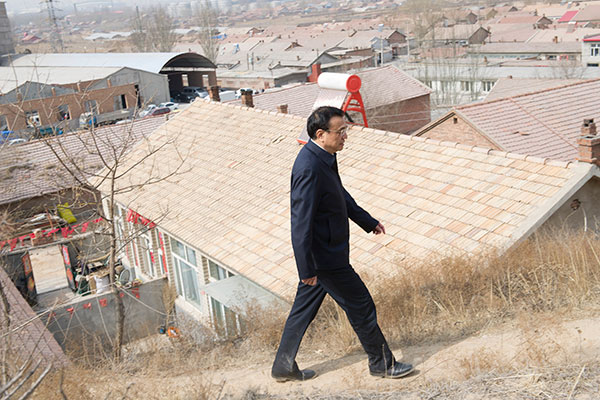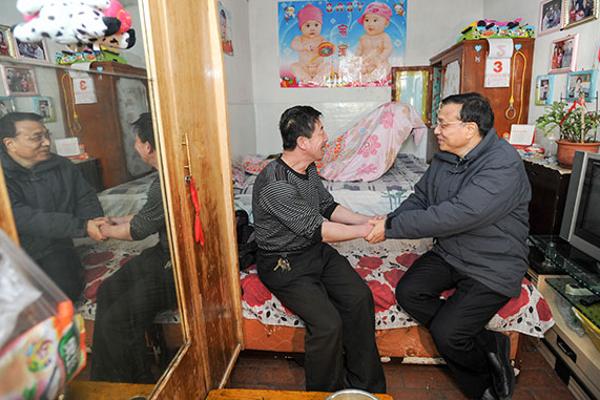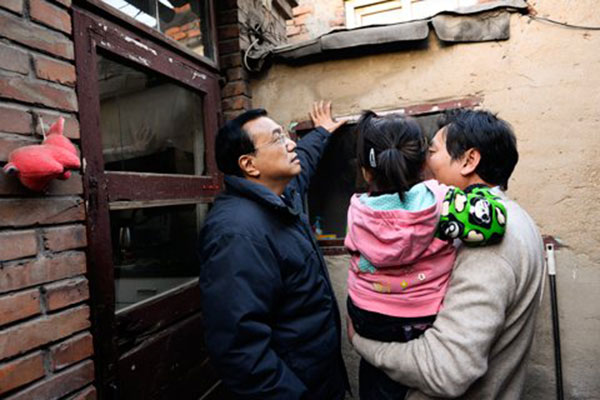
Gao Junping’s dream is to have Premier Li Keqiang visit his new home in North China’s Inner Mongolia autonomous region after the 58-year-old retired worker and his family waved goodbye to the shantytown he visited three years ago.

Li, then vice-premier, visited Gao’s shanty home on Feb 3, 2013. For more than 50 years Gao and his family lived in a home covering about 20 square meters, and he never thought he would ever move into a new house away from the area that was home to about 124,000 people who lived similarly to him.
When at Gao’s house, he said the government was speeding up shantytown renovation, and hoped they could move and enjoy a better quality of life.
He also said that for families in the shanty towns, housing is the top priority, so renovation must be speeded up.
Four months after the Premier’s second visit last year, the local government began work in the shanty areas and moved the first batch of families into new houses. Gao and his family moved to their new house less a year after Premier Li’s second visit.
The Premier’s efforts to renovate shanty towns has achieved results, as by last year the government has renovated about 20.8 million shanty houses and 15.65 million dangerous homes in rural areas.

Gao is not the only one to have benefited from the country’s shantytown renovation projects. Li Zhongyi, 77, from Tianjin has also moved to her new house from the shantytown where she lived for more than half a century.
The Premier promised her a new house with a kitchen, washroom and heating when visiting on Dec 27, 2013. As there was little room in her home he sat on her bed where he asked about local people’s living conditions, later visiting other inhabitants.
The Premier told villagers that “the Party and government will not let you live in such conditions within a big city”. He went on to say that “the coexistence of high buildings and shantytown dwellers should not be allowed. Everyone has the right to live in a new house and of leading a better life”.
Renovation work started three days after the Premier’s visit. In September, 2014 when he visited again, Li Zhongyi was selecting her new house with several neighbors.
Shantytown renovation has been uppermost in Premier Li’s mind since his days as vice premier and later premier and probably relates to his experiences when he worked in Liaoning.
On Dec 26, 2004, after taking office as secretary of the Liaoning Provincial Committee of the Communist Party of China, he visited Modigou, the most remote and poorest area in Fushun, Liaoning province.
He went to the home of two elderly people in a temperature of 30 degrees below zero, finding that cold wind was blowing into the house through cracks in the walls and water had turned into ice.
Witnessing the abject living conditions of shantytown residents he promised to make every effort to move them out.
Four days later, during the eighth plenary session of the ninth CPC Liaoning Provincial Committee, renovation was listed as the ‘No 1 livelihood project’ of the province, heralding the start of the renovation project.
At a State Council executive meeting in this June, the Premier said that from 2015 to 2017, the government will renovate 18 million homes in shanty towns, including dangerous houses and villages in cities, and 10.6 million dangerous houses in rural areas.
“There are still about 100 million people living in urban shantytown areas, and many of them in old houses, and China will continuously promote shantytown renovation”, said Li at the Davos Forum in Tianjin in September.
The Premier also said shanty towns are scars on a city and that there are many such areas nationwide, but with persistent efforts the scars will finally be healed.
